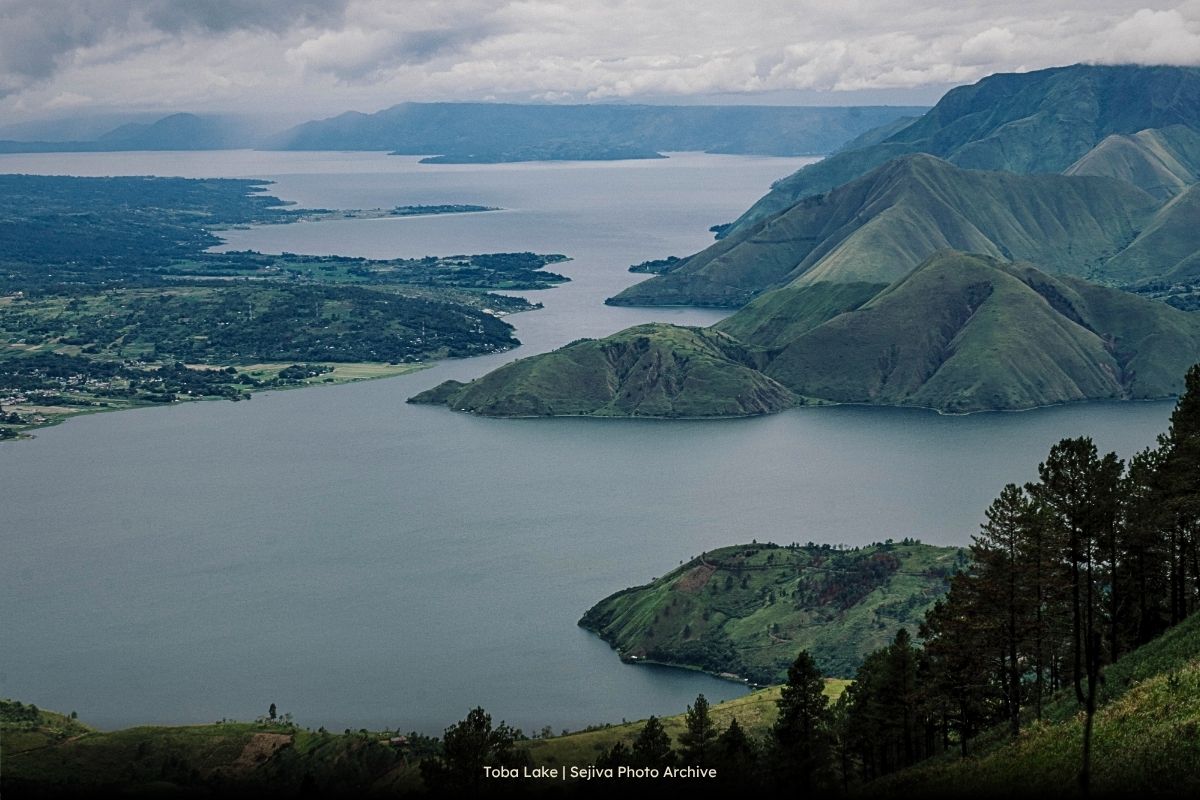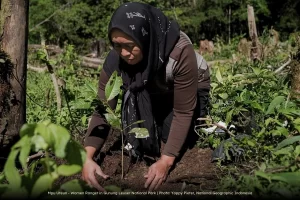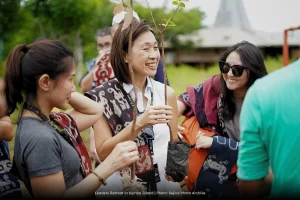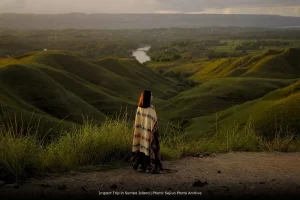Nestled in the highlands of North Sumatra, Lake Toba is not just a lake, but a living legacy of one of the most powerful volcanic eruptions in Earth’s history. This colossal volcanic crater lake in North Sumatra, formed over 74,000 years ago, is the heart of the Toba caldera, a marvel of geological wonder and a symbol of resilience and rebirth.
Today, Lake Toba isn’t just a geological attraction. It’s a soulful destination where nature, culture, and local legends merge to create a deeply enriching experience. Whether you’re gazing over its shimmering waters, learning the intricacies of Batak culture, or exploring sacred landscapes, Lake Toba offers more than a vacation, it offers connection.
the origin of lake toba: a volcanic marvel
Around 74 millennia ago, a cataclysmic eruption, the largest in the last two million years—reshaped the face of Southeast Asia. The Lake Toba volcano unleashed a supereruption so immense that it is believed to have triggered a global volcanic winter, possibly reducing the global human population to a mere fraction of what it once was.
The aftermath of that eruption is what we now see as Lake Toba: a stunning body of water measuring roughly 100 km in length and 30 km across, with a depth reaching over 500 meters. This is Lake Toba Indonesia, the largest volcanic lake in the world, and a window into the Earth’s tumultuous past.
But despite its violent origin, today Lake Toba exudes serenity. Steam rises from fumaroles, and hot springs bubble gently on the shores, a subtle reminder of the power that lies dormant beneath.
exploring the beauty of lake toba, indonesia
Travelers arriving at Lake Toba are greeted with a sense of peace. The cool mountain air, the quiet hum of nature, and the stillness of the water invite you to slow down. Whether you’re arriving from Medan or flying into the nearby Silangit Airport, the moment you glimpse the lake from above, you’ll feel its magnetic pull.
For unforgettable views, head to Sipinsur Park Geosite, located in Humbang Hasundutan. This scenic lookout offers sweeping panoramas of the lake, framed by misty pine forests and distant hills. It’s one of the most photogenic spots around the caldera and a favorite among geology enthusiasts and casual travelers alike.
Elsewhere, nature continues to impress. Sipiso-Piso Waterfall, tumbling 120 meters into a lush gorge, provides a dramatic contrast to the lake’s calmness. Surrounded by cliffside views, it’s the perfect place to pause and absorb the elemental beauty of North Sumatra.
Adventure seekers can explore hidden trails, kayak across the lake’s surface, or take boat rides between traditional villages, discovering new angles of this majestic landscape at every turn.
Also Read: Mount Rinjani: Hidden Paradise in Lombok
a cultural stop: sipinsur park geosite and local legends
Sipinsur Park Geosite is not just a vantage point, it’s a bridge between science and storytelling. Here, visitors can learn about the caldera’s geological formation while engaging with the folklore of the Batak people. According to one beloved legend, the lake was formed not by fire and ash, but by a divine love story gone wrong.
The tale tells of a fisherman named Toba who married a woman from the sea, under the condition that he never reveal her true origins. When he broke his promise, a massive flood followed, and Lake Toba was born. Their son, who turned into Samosir Island, became the spiritual link between the lake and its people.
Locals still share this story with pride, reminding travelers that myths often hold deeper truths. And in places like Sipinsur, these truths are embedded in the land, stones, and songs of the Batak community.
visit samosir island: culture, nature, and history
Located at the center of Lake Toba, Samosir Island is often considered the cultural soul of the region. Although technically a peninsula now, due to a man-made connection, it feels peaceful, spiritual, and full of life.
Samosir is home to numerous traditional Batak houses, with their curved, boat-like roofs and decorative carvings that depict ancestral stories. These homes are not just architectural wonders but expressions of identity and lineage. In the town of Tuk Tuk, many such homes have been turned into comfortable guesthouses, allowing travelers to stay in and experience living like a local.
A visit to Ambarita Village unveils the ancient stone chairs, once used for tribal justice. The experience is both chilling and fascinating, offering a rare glimpse into pre-colonial governance. In Tomok Village, you’ll find the tombs of Batak kings, intricately carved and preserved as a testament to the region’s rich royal heritage.
Outdoor enthusiasts can hike up Mount Pusuk Buhit, considered sacred as the mythical birthplace of the Batak people. The trail is adorned with small shrines and scenic stops, each offering panoramic views of the lake below.
From exploring ancient rituals to chatting with fishing village elders, every corner of Samosir Island invites a deeper appreciation for how culture and nature coexist.
meet tari sigale gale: the enchanting puppet dance of lake toba
In the heart of Tomok Village, a unique cultural treasure comes to life: Tari Sigale Gale, the puppet dance that blurs the line between the living and the spiritual world. This performance features a life-sized wooden puppet that mimics human movement with haunting accuracy.
Historically, the dance was performed during the funerals of noble families who had no children. It was believed the puppet could serve as a symbolic child to send the spirit of the deceased peacefully to the afterlife.
Today, this tradition continues not only as a performance art but also as a way to pass on cultural knowledge to younger generations. Accompanied by traditional Batak music, the puppet is animated by dancers from within, creating an almost lifelike motion that mesmerizes audiences.
For visitors, Tari Sigale-Gale is a beautiful yet somber reminder of the spiritual depth and emotional richness embedded in the Batak identity.
sejiva’s tips for exploring lake toba
At Sejiva, we encourage experiences that are not only immersive but also leave a positive impact on the places and people you encounter. Here’s how to make your trip to Lake Toba truly unforgettable, and positive:
1. Travel Mindfully
Take time to appreciate not just the sights, but the stories. Visit community-run geosites and support cultural preservation projects.
2. Stay with the Locals
Opt for locally owned accommodation such as hotels, homestays, and eco lodges. Many of these accommodations offer cooking classes, textile weaving experiences, and evening storytelling sessions.
3. Explore with Purpose
Hire local guides who can share deeper insights into Batak mythology, historical landmarks, and hidden natural wonders that don’t show up on Google Maps.
4. Eat and Shop Sustainably
Try local dishes like naniarsik (spicy carp), saksang (pork with blood and spices), and freshly harvested lake fish grilled in banana leaves. Support artisans by buying handwoven ulos cloth, pottery, and wood carvings.
5. Respect Local Customs
When visiting traditional sites or ceremonies, dress modestly and always ask before taking photographs. Many villages still maintain sacred traditions and values.
6. Embrace the Unexpected
Allow space for spontaneous conversations, invitations to local weddings, or unplanned hikes. These often become the most treasured parts of your journey.
final thoughts: more than a destination
Lake Toba is more than a place, it’s a narrative carved into the Earth, echoed in Tari Sigale-Gale, whispered through pine trees at Sipinsur Park, and carried in the stories of villagers on Samosir Island. It invites not just exploration, but transformation.
In an age of instant travel and over-planned itineraries, Lake Toba stands as a reminder of why we travel in the first place: to connect, to learn, and to be moved.Ready to experience the power and poetry of Lake Toba?
Let Sejiva help you craft a journey that’s not just scenic, but soulful, where every step contributes to the land and lives that make this volcanic wonder so unforgettable.










